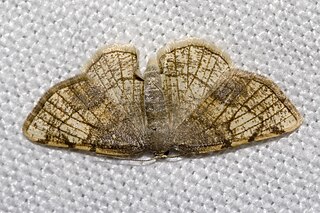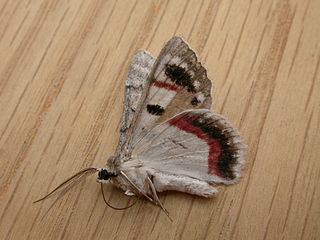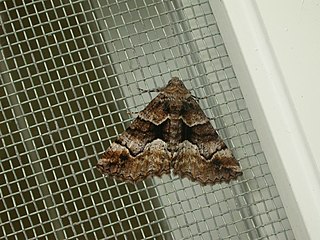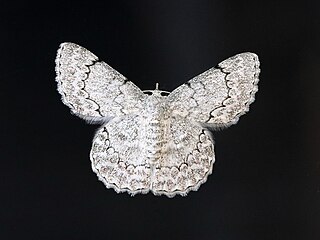
The geometer moths are moths belonging to the family Geometridae of the insect order Lepidoptera, the moths and butterflies. Their scientific name derives from the Ancient Greek geo γεω, and metron μέτρον "measure" in reference to the way their larvae, or inchworms, appear to measure the earth as they move along in a looping fashion. A very large family, it has around 23,000 species of moths described, and over 1400 species from six subfamilies indigenous to North America alone. A well-known member is the peppered moth, Biston betularia, which has been subject of numerous studies in population genetics. Several other geometer moths are notorious pests.

The Macariini are a tribe of geometer moths in the subfamily Ennominae. Though they share many traits with the Sterrhinae, this is probably plesiomorphic rather than indicative of a close relationship, and DNA sequence data points to the Boarmiini as particularly close relatives of the Macariini. All things considered, this tribe might still resemble the first Ennominae more than any other living lineage in the subfamily.

Ennominae is the largest subfamily of the geometer moth family (Geometridae) with some 9,700 described species in 1,100 genera. Most species are fairly small, though some grow to be considerably large. This subfamily has a global distribution. It includes some species that are notorious defoliating pests. The subfamily was first described by Philogène Auguste Joseph Duponchel in 1845.

The Bistonini are a tribe of geometer moths in subfamily Ennominae. As numerous ennomine genera have not yet been assigned to a tribe, the genus list is preliminary. In addition, the entire tribe is sometimes merged into a much-expanded Boarmiini. In other treatments, the Erannini are included in the present group.

The Ourapterygini are one of the large tribes of geometer moths in the subfamily Ennominae. The tribe was described by Charles Théophile Bruand d'Uzelle in 1846. They are particularly plentiful in the Neotropics. Ourapterygini are generally held to be the youngest tribe of their subfamily, and at least seasonally have characteristic apomorphic asymmetrical processes of the anellus.

The Abraxini are a tribe of geometer moths in the subfamily Ennominae. Here, the Cassymini are considered a specialized offshoot of the Abraxini and merged therein; some authors consider them a distinct tribe however.

Larentiinae is a subfamily of moths containing roughly 5,800 species that occur mostly in the temperate regions of the world. They are generally considered a subfamily of the geometer moth family (Geometridae) and are divided into a few large or good-sized tribes, and numerous very small or even monotypic ones which might not always be valid. Well-known members are the "pug moths" of the Eupitheciini and the "carpets", mainly of the Cidariini and Xanthorhoini. The subfamily was described by Philogène Auguste Joseph Duponchel in 1845.

The Cidariini are the largest tribe of geometer moths in the subfamily Larentiinae. The Cidariini include many of the species known as "carpets" or, ambiguously, "carpet moths", and are among the few geometer moths that have been subject to fairly comprehensive cladistic study of their phylogeny. The tribe was described by Philogène Auguste Joseph Duponchel in 1845.

The Nacophorini are one of the smaller tribes of geometer moths in the subfamily Ennominae. They are the most diverse Ennominae of Australia and are widespread in the Americas. If the African genera tentatively placed herein indeed belong here, the distribution of the Nacophorini is distinctly Gondwanan, with their probable origin either of Australia, South America or even Antarctica. In Eurasia, they are rare by comparison.

Crypsiphona ocultaria the red-lined looper moth or red-lined geometer, is a moth of the family Geometridae. The species was first described by Edward Donovan in 1805 and it is found in Australia.

Didymoctenia is a monotypic moth genus in the family Geometridae and subfamily Ennominae which was described by Warren in 1901. Its only species, Didymoctenia exsuperata, the thick-lined bark moth, was first described by Francis Walker in 1860. It is found in Australia.

Gastrina is a monotypic moth genus in the family Geometridae. Its only species, Gastrina cristaria, the wave-lined geometrid, is found in the south-eastern quarter of Australia. Both the genus and species were first described by Achille Guenée in 1857.

Phelotis is a monotypic moth genus in the family Geometridae erected by Edward Guest in 1887. Its single species, Phelotis cognata, the long-fringed bark moth, first described by Francis Walker in 1860, is found in Australia.

Sterrhinae is a large subfamily of geometer moths with some 3,000 described species, with more than half belonging to the taxonomically difficult, very diverse genera, Idaea and Scopula. This subfamily was described by Edward Meyrick in 1892. They are the most diverse in the tropics with the number of species decreasing with increasing latitude and elevation.

Scopulini is a tribe of the geometer moth family (Geometridae), with about 900 species in seven genera. The tribe was described by Philogène Auguste Joseph Duponchel in 1845.

Pingasa chlora, the white looper moth or flower-eating caterpillar, is a species of moth of the family Geometridae first described by Caspar Stoll in 1782. It is found Sundaland, the Philippines, Sulawesi and from the Moluccas to Queensland, Australia.
Louis Beethoven Prout (1864–1943) was an English entomologist and musicologist.

Scopula caesaria is a moth of the family Geometridae. It has a wide range, including the Comoros, Mayotte, La Réunion, Madagascar and in Mauritius, Nigeria, South Africa, Tanzania, Gambia, Oman, the United Arab Emirates, New Guinea, Taiwan, Japan and Australia (Queensland).
William Warren was an English entomologist who specialised in Lepidoptera.

















